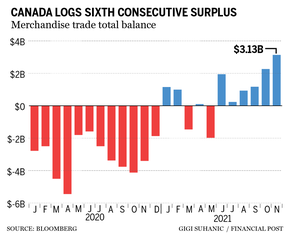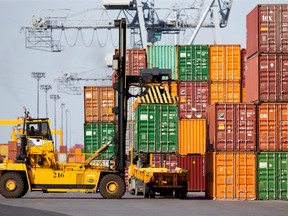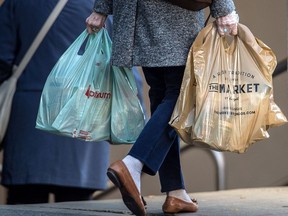Data another positive signal for the Bank of Canada
Article content
Canada’s trade surplus widened for a sixth straight month in November, easing worries around the economic impact of the British Columbia floods, and providing further evidence the economy was building up strength ahead of the Omicron surge.
Advertisement
This advertisement has not loaded yet, but your article continues below.
Article content
The gap between the value of exports and imports was $3.1 billion in November, the largest in 13 years, compared with $2.3 billion in October, Statistics Canada reported on Jan. 6.
Merchandise exports increased 3.8 per cent to $58.6 billion, and imports increased to a record $55.4 billion. Both figures were influenced by COVID-19 medication, including exports, as a large shipment was imported for labelling and packaging before being shipped back out.

Still, there was evidence of solid demand beyond the idiosyncrasies of the global trade in vaccines. Exporters of chemicals, energy and lumber all posted impressive gains, a positive for a country that counts on international demand for its goods and services for a significant amount of its wealth.
Advertisement
This advertisement has not loaded yet, but your article continues below.
Article content
“We had the trade surplus rise to the strongest it’s actually been since the global financial crisis. So, a very positive result indeed,” Stephen Brown, senior economist at Capital Economics, said in an interview.
The Bank of Canada will take the data as another indication of the strength of the economy as it tries to sort out when to begin lifting interest rates. Royal Bank of Canada deputy chief economist Dawn Desjardins suspects the economy has built up enough momentum in the last half of 2021 to help it through any impacts imposed by the highly transmissible Omicron variant.
“I don’t necessarily think this is going to be sufficient enough to see (the Bank of Canada) pivot away from the idea that the economy no longer needs these extraordinarily low interest rates,” Desjardins said of the spread of COVID-19 and the central bank’s response.
Advertisement
This advertisement has not loaded yet, but your article continues below.
Article content
-
Financial Post’s Economic tracker
-

Ottawa orders 140 million rapid test kits as it prepares to live with Omicron
-

Canada loses to U.S. in trade spat as panel says dairy rules defy pact
-

Manufacturers fear Omicron wave could exacerbate staff shortages
Exports from B.C. declined eight per cent in November, when epic floods and landslides impeded access to the Port of Vancouver, the country’s main gateway to trade with Asia. Bay Street economists had assumed the disruption would cause Canada’s export momentum to stall. However, an 11-per-cent jump in exports from the rest of the provinces outweighed B.C.’s troubles.
Exports of chemicals, plastics and rubber products rose 14.7 per cent, while energy exports continued to climb at 2.8 per cent, a seventh straight increase in 2021.
Advertisement
This advertisement has not loaded yet, but your article continues below.
Article content
Consumer goods imports continued to rise as well, climbing 5.2 per cent. Imports of metals increased by 7.3 per cent after falling 8.2 per cent in October. Though imports grew overall, there was a 3.4 per cent decline in electronic and electrical equipment and a 0.8 per cent drop in machinery and equipment imports, an indication domestic business investment took a hit that month, Brown said.
The floods, which stalled freight lines and cut off highway access, likely played a part in larger supply chain disruptions across the globe that affected firms’ ability to purchase electronics and equipment that month. Still, it’s a small worry, overshadowed by the reconstruction effort and indications from close to half of businesses surveyed by the Bank of Canada that they intend to invest more over the next year.
“As soon as these products are available, (firms) are going to start investing,” Brown said. “Because of the strength of the fourth quarter, some of that weakness we’re going to get in January and February isn’t going to be as much of an issue.”
• Email: bbharti@postmedia.com | Twitter: biancabharti
Advertisement
This advertisement has not loaded yet, but your article continues below.
Canada’s trade surplus swells to 13-year high
2022-01-06 20:38:59






